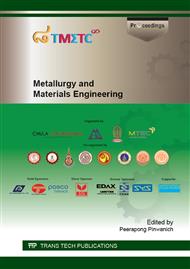p.69
p.76
p.81
p.86
p.91
p.96
p.101
p.106
p.111
Influence of Flux-Core Arc Welding Parameters on Erosion Resistance of Stellite 12
Abstract:
Due to high wear resistance, Cobalt-based alloys, such as Stellite12 (52Co30Cr8.5W), have presently been used as materials for hardfacing in several applications. Thermowell, a protecting part for thermocouple in petrochemical production, is also coated by Stellite12. Because of high deposition rate, the flux-core arc welding (FCAW) method was selected to be hardfacing process in the research. However, their welding parameters should be exactly controlled in order to obtain desired properties, depending on the microstructure of this material. The objective of this experiment is to study the influence of the FCAW parameters on the erosion resistance of AISI 304 (Fe-18Cr-8Ni-0.06C) welded by the cobalt base alloy filler, Stellite12 (Co-30Cr-8.5W-1.5C) as the hardfacing layer. The studied parameters were welding speed in the range of 2.1-8.5 mm s-1, and wire feed speed in the range of 42.3-67.7 mm s-1, leading to different heat inputs and cooling rates. The erosion resistance was investigated by using solid particle erosion test rig at ambient temperature. Surface characterization was then carried out by SEM equipped EDX and XRD. The results showed the relationship between erosion resistance and microstructure in welding and HAZ zone. The erosion resistance was depended on the formation of interdendritic phase in the welding zone. According to the surface examination, it was found that the formation of interdendritic, including size and shape played an important role on the erosion resistance. The heat input and cooling rate concerned with welding parameters was further discussed with the erosion behavior in this research.Keywords Stellite12, Cobalt base alloys, Flux-core arc welding, FCAW, Erosion-resistance
Info:
Periodical:
Pages:
91-95
Citation:
Online since:
July 2015
Authors:
Keywords:
Price:
Сopyright:
© 2015 Trans Tech Publications Ltd. All Rights Reserved
Share:
Citation:


